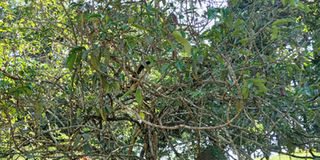How scientists are conserving plants

Wild coffee plant under preservation at Botanical Gardens. Photo / Lominda Afedraru
What you need to know:
- Most food energy the world population consumes comes from three species namely wheat, rice and maize. That is a very limited and narrow diet, considering the vast numbers of plant species that are available to provide food to people or diversity to crop breeding programmes.
The world we live in is ever changing, growing and facing new challenges on a daily basis including threats to the plants that sustain our existence.
Scientists explain that 20 percent of all plant species are threatened with extinction, including many wild plants that are closely related to our crops and hold the potential to adapt agriculture to unprecedented changes.This is as a result of climate change challenges which is causing pest and disease infection to crops and crop failures due to prolonged drought and erratic rains.
Most food energy the world population consumes comes from three species namely wheat, rice and maize. That is a very limited and narrow diet, considering the vast numbers of plant species that are available to provide food to people or diversity to crop breeding programmes.
As such there is deliberate effort by agricultural scientists at the Plant Genetic Resources Centre (PGRC) to collect plant species across the country which are preserved for scientific use as well as for purposes of regeneration in case of extinction.
Background
The Plant Genetic Resources Centre is an institution under the National Agricultural Research Laboratories (NaRL) of the National Agricultural Research Organisation (Naro).
It is an entity comprising the historical Entebbe Botanic Gardens (EBG) and the Uganda National Gene Bank (UNGB).
The gardens were established by the British protectorate in 1890 with the main objective to conduct agricultural research in plants with commercial interest for industrial revolution of Europe as well conserve crop resources that can be kept for future generation.
Crops
Dr Catherine Kiwanuka, a senior officer at the PGRC, explains that the main things that constitute the gardens include semi domesticated plants used for food, the wild relatives of crops such as rice, sorghum, coffee, millet, tomatoes and beans among others including exotic plants such as rubber tree.
Other tree species are mivule, mahogany, eucalyptus and ornamentals such as cedars, Mediterranean cypress, cannon ball tree, coco nut, Indian Lilac, Borassus aethiopum palm and oil palm (ad hoerscassia) among others
Conservation strategies
Dr Kiwanuka says her team uses two methods of conserving the plants which include ex-situ meaning the plants are collected from the wild and planted in selected protected farms owned by farmer associations or individual farmers in various locations across the country.
The other method is in- situ method of conserving mainly in the gene bank which was established in 2004 where seed is kept in refrigerators and plant collection across the country conserved at the protected botanical gardens.
The seed bank
The gene bank manager Eva Zaake informs Seeds of Gold that her team has conserved seed of crops consumed by the population in the country.
This includes various varieties of beans, sesame (simsim), millet, sorghum, groundnuts, bambara nut which is mainly grown by farmers in West Nile region, rice, maize barley, soybean, lentil, common pea, sunflower and green gram among others.
Apart from the above seeds, the team is also preserving seeds of forage crops used for planting such as Chloris, Brachiaria, Cenchrus, Panicum and the legumes Clitoria ternatea, Desmodium and Cenrosema.
Most of these seeded crops have wild varieties in the wild, some of their seeds are also being preserved in the seed bank to avoid extinction.
Processing seed
Gordon Nsamba, a laboratory technician at the gene banks explains that once the scientists sample seeds of the various crops of interest for preservation, the first step is to test its viability using soil mixed with water in bowl and if it geminates it means it is good.
The seed is then multiplied by allowing it to grow and a selection is done after harvesting and drying.
The moisture rate is then tested using a moisture meter and the acceptable rates are five, six, and seven degrees Centigrade.
Its germination rate is tested again with samples of seeds at the germination chamber and the period varies per crop, a case in point is for maize seed which takes place in two weeks.
After this process, the seed is waxed and kept either in glass boxes or in paper boxes which are also waxed to avoid moisture from entering.
It is kept under refrigeration and its germination viability can last more than 50 years.
Regional banks
Dr Kiwanuka contends that there is need to intensify the process of setting up regional gene banks and botanical gardens to increase on the rate of plant conservation in the country.
This, he says is because climate change effects are a risk to all plant varieties in the country and in sub Saharan Africa where most plants are shared by the countries.
In the case of Uganda, there are some plant species that are meant to thrive in semi - arid areas such as Karamoja.
Therefore such a plant cannot be preserved at the Botanical Garden because central Uganda is humid and such a plant will only dry up.
In the case of seed banks, the team has established community seed banks in most regions across the country which are being managed by farmer groups.
Process
The first step is to test its viability using soil mixed with water in bowl and if it geminates it means it is good.
The seed is then multiplied by allowing it to grow and a selection is done after harvesting and drying.
The moisture rate is then tested using a moisture metre and the acceptable rates are five, six, and seven degrees Centigrade.




